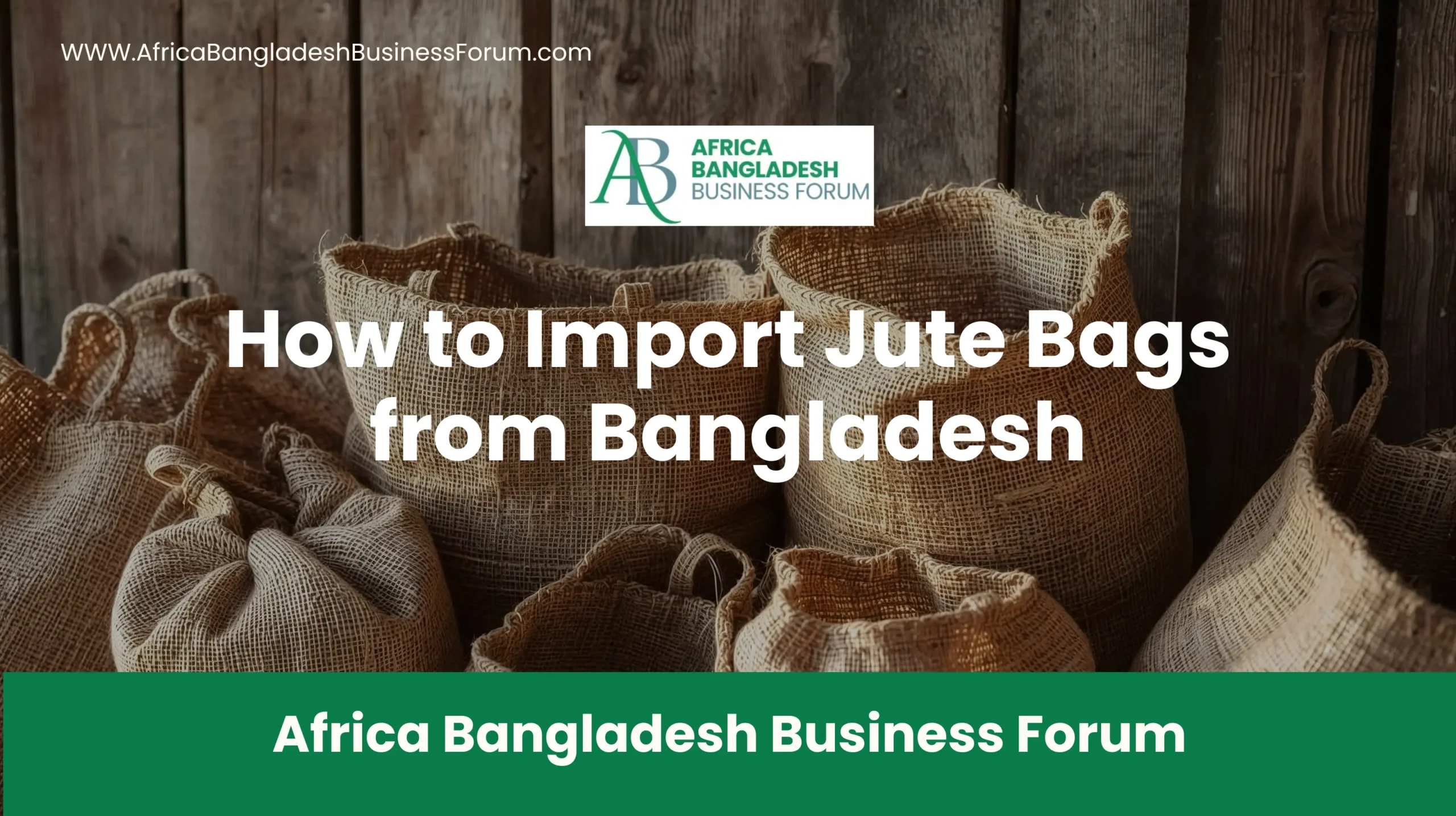
How to Import Jute Bags from Bangladesh: A Step-by-Step Guide
With growing concerns over sustainability, many businesses are turning to eco-friendly products, and jute is leading the way. Known as the “Golden Fiber,” jute comes from Bangladesh, one of the top global manufacturers of durable and versatile jute products, including jute bags. This step-by-step guide is designed for businesses, especially in Africa, that are looking to import high-quality jute bags from Bangladesh.
Bangladesh has long been a key supplier of jute sacks, garments, textiles, footwear, and other essential goods to the world. By following this guide, international buyers can confidently source jute bags and navigate the process of importing these sustainable products from Bangladesh.
Step 1: Finding Verified Jute Bag Suppliers in Bangladesh
Finding a reliable jute bag supplier is the first and most critical step in the import process. While searching online can be overwhelming, using specialized platforms can save time and help you connect directly with trusted exporters.
The Challenge of Sourcing
One of the biggest challenges when sourcing jute bags from Bangladesh is ensuring that the suppliers are reputable and reliable. Without proper vetting, you could end up with poor-quality products or delayed shipments.
Leverage B2B Trade Platforms
B2B marketplaces are the most efficient way to connect with Bangladeshi suppliers. These platforms allow you to communicate directly with manufacturers and request quotes, samples, and more.
Spotlight on Kingmansa
Kingmansa is a leading B2B marketplace specifically designed to bridge the gap between Africa and Bangladesh. This platform provides a curated list of verified Bangladeshi jute bag manufacturers, offering secure communication channels and a user-friendly interface for requesting quotations.
Utilize Business Forums for Networking
In addition to B2B platforms, business forums provide valuable opportunities to network and build direct relationships with suppliers. The Africa Bangladesh Business Forum (ABBF) is an essential platform for B2B matchmaking. It allows you to connect with top Bangladeshi exporters, policymakers, and trade officials.
Step 2: Requesting Quotes and Product Samples
Once you’ve identified potential suppliers, the next step is to verify the quality of the jute bags and negotiate the terms of the deal.
Submit a Detailed Request for Quotation (RFQ)
When you reach out to suppliers, be specific about your needs. Include details such as:
- Bag dimensions
- Handle type
- Printing requirements (logos, colors)
- Desired quantity
This will help you get accurate quotes and avoid misunderstandings down the line.
Always Order Samples
This is a non-negotiable step. Ordering a sample allows you to physically inspect the quality of the jute bags, including the strength of the stitching, print accuracy, and overall durability. This is crucial, whether you’re looking for a “custom clothing manufacturer” or a “wholesale eco-friendly jute bag supplier.”
Verify Business Credentials
Before proceeding, it’s important to verify the business credentials of the supplier. Check for essential documents, such as:
- Export licenses
- Factory certifications (e.g., ISO)
- Membership in trade bodies
Step 3: Negotiating Payment and Shipping Terms
Once you’ve confirmed the supplier’s reliability, the next step is negotiating payment and shipping terms. Clear agreements at this stage will prevent issues later.
Payment Methods
Letter of Credit (L/C): This is the most secure payment method for international trade. It guarantees payment to the seller as long as the terms of the agreement are met.
Telegraphic Transfer (T/T): This is another common payment method but usually requires an advance payment (e.g., 30% upfront, 70% upon shipment).
Understand Incoterms
Incoterms such as FOB (Free on Board) and CIF (Cost, Insurance, and Freight) define the buyer’s responsibilities for the costs and risks involved in shipping. Understanding these terms will help you avoid unexpected costs.
Finalize the Sales Contract
A formal contract should outline all agreed-upon terms, including production lead times, delivery schedules, and payment details. This contract serves as a legally binding document to ensure both parties adhere to the agreement.
Step 4: Managing Production, Inspection, and Shipping
Overseeing the production process ensures you receive exactly what you ordered. Communication and monitoring are crucial at this stage.
Production Monitoring
Ask your supplier for regular updates during the production process. This will give you peace of mind and ensure everything is on track.
Pre-Shipment Inspection (PSI)
Before the jute bags are shipped, hire a third-party inspection company in Bangladesh to verify the quality and quantity of the goods. This inspection should cover everything from bag quality to packaging.
Logistics and Freight
Your supplier can arrange for shipping, or you can hire your own freight forwarder. Sea freight is the most common and cost-effective method for large shipments of jute bags.
Step 5: Customs Clearance and Final Delivery
After your jute bags are shipped, the final step is clearing customs and getting the goods to your warehouse.
Prepare Necessary Documents
For customs clearance, you’ll need the following documents:
- Commercial Invoice
- Packing List
- Bill of Lading
- Certificate of Origin
Hire a Customs Broker
If you’re new to importing, hiring a customs broker is a good idea. A broker will ensure all import duties and taxes are paid and help with paperwork.
Arrange Local Delivery
Once the goods clear customs, arrange for delivery from the port to your warehouse. This may require local transportation services.
Simplify Your Import Journey with ABBF and Kingmansa
Importing jute bags doesn’t have to be complicated. The Africa Bangladesh Business Forum (ABBF) and Kingmansa make it easier to connect with verified suppliers, manage the entire import process, and ensure smooth transactions.
Connect with Confidence
With Kingmansa, you can easily find pre-vetted, export-ready jute bag suppliers from Bangladesh. You’ll be able to communicate directly with manufacturers and get quotes quickly.
Gain a Trusted Partner
The ABBF provides a platform for B2B matchmaking and access to important trade insights. Whether you’re looking for exporters, importers, or investors, the forum helps you make informed decisions.
Ready to source high-quality jute bags from Bangladesh?
- Visit Kingmansa.com to browse suppliers and start your import journey today!
- Join the Africa Bangladesh Business Forum to unlock more trade opportunities.
Call to Action
Join the Africa Bangladesh Business Forum (ABBF) today to start your export journey to Africa. With access to trade fairs, business forums, and a network of reliable partners, you will be well-equipped to grow your business and succeed in the African market.
Book a CallFrequently Asked Questions
1. Why should I import jute bags from Bangladesh?
Bangladesh is the world’s leading producer of jute, known as the “Golden Fiber.” The country offers a diverse range of high-quality, eco-friendly jute products, including bags, sacks, and textiles. Importing from Bangladesh provides access to competitive pricing, customization options, and a robust supply chain. Additionally, sourcing jute products supports sustainable practices and aligns with the growing global demand for biodegradable alternatives to plastic.
2. How do I find reliable jute bag suppliers in Bangladesh?
To identify trustworthy suppliers, consider using B2B platforms like Kingmansa, which connects African businesses with verified Bangladeshi exporters. These platforms offer access to a curated list of manufacturers, secure communication channels, and tools to request quotations. Additionally, participating in business forums such as the Africa Bangladesh Business Forum (ABBF) can facilitate direct networking and B2B matchmaking opportunities.
3. What are the essential steps for importing jute bags?
The import process involves several key steps:
- Finding Verified Suppliers: Utilize B2B platforms and business forums to connect with reputable manufacturers.
- Requesting Quotes and Samples: Submit detailed Requests for Quotation (RFQs) specifying your requirements and always order samples to assess product quality.
- Negotiating Payment and Shipping Terms: Agree on secure payment methods like Letter of Credit (L/C) or Telegraphic Transfer (T/T) and understand Incoterms such as FOB and CIF.
- Managing Production and Inspection: Monitor production progress and arrange for Pre-Shipment Inspections (PSI) to ensure product quality.
- Customs Clearance and Delivery: Prepare necessary documents for customs clearance and arrange for local delivery to your warehouse.
4. Are there any trade restrictions on importing jute bags from Bangladesh?
Yes, certain trade restrictions may apply. For instance, India has imposed restrictions on the import of specific jute products, including jute sacks and bags, from Bangladesh via land ports. These imports are now permitted only through the Nhava Sheva Seaport in Maharashtra. It’s essential to stay informed about the latest regulations and ensure compliance with the importing country’s laws to avoid disruptions in your supply chain.
5. How can I ensure the quality of the jute bags I import?
To guarantee product quality:
- Order Samples: Always inspect physical samples before placing bulk orders to assess material quality, stitching, and print accuracy.
- Verify Supplier Credentials: Check for essential documents like export licenses, factory certifications (e.g., ISO), and memberships in trade bodies.
- Conduct Pre-Shipment Inspections (PSI): Hire third-party inspection companies in Bangladesh to verify the quality and quantity of the goods before shipment.
- Monitor Production Progress: Request regular updates from your supplier during the manufacturing process to ensure adherence to agreed-upon specifications.

